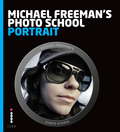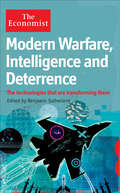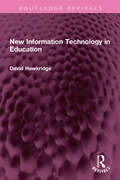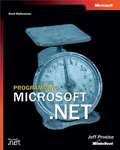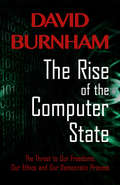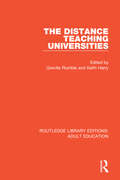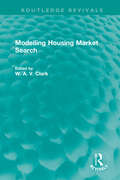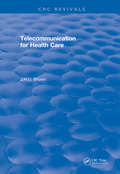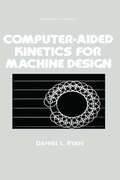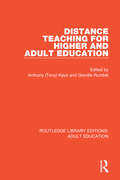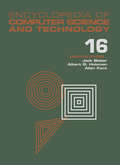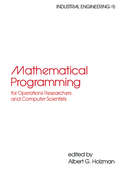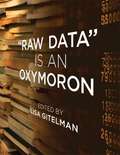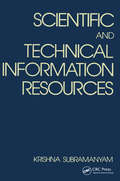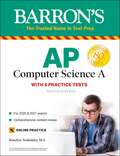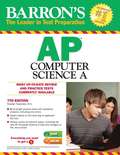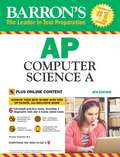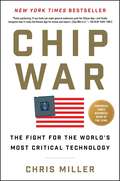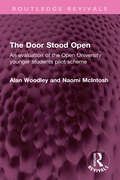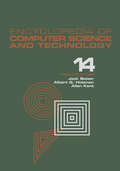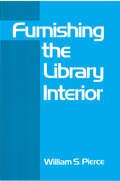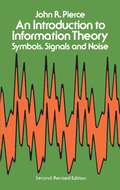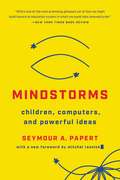- Table View
- List View
Michael Freeman's Photo School: Portrait (Michael Freeman's Photo School)
by Michael FreemanAt some point, all photographers are called upon to shoot a proper portrait - combining technical skill with personable demeanour to capture someone in their best possible light. Michael Freeman teaches you how to achieve flattering portrait results with a variety of both traditional and modern styles.Learn how to set your subjects at ease and bring out their natural beauty with a friendly yet professional attitude. Feel confident giving directions on posing and stance with a thorough review of the classic approaches, from head-and-shoulder shots to full-length compositions, and everything in between.Take creative control of your portrait sessions by learning to manipulate the light to your own ends - whether that means bouncing sunlight o a reflector or building your own studio setups with multiple fl ash units. The complex science of photographic lighting is explained in straightforward and easy-to-understand language, with abundant and inspirational examples. Finally, master the fundamentals of post-production finishing techniques to make sure every portrait looks its absolute best. Your subjects will thank you for it!
Mind at Play: The Psychology of Video Games
by Geoffrey. R. Loftus Elizabeth F. LoftusExamines the psychological processes involved in playing video games, discusses behavior problems frequent players can develop, and compares video games to other fads of the past.
Modern Warfare, Intelligence and Deterrence: The technologies that are transforming them (Economist Books)
by Benjamin SutherlandThe Panzerfaust-3, a German shoulder-fired heat-seeking antitank missile, can punch through a metre of solid steel-far more than any armoured vehicle could carry. The MPR-500, an Israeli precision bomb, can hammer through several storeys of a building and explode on a chosen floor. These and myriad other military and intelligences technologies are changing the world. This Economist book describes these emerging technologies and places them in the larger context of today's politics, diplomacy, business and social issues. It shows how efforts to win wars or keep the peace are driving enormous and multifold technological advances. Broadly speaking, defence technologies will continue to provide enormous advantages to advanced, Western armed forces. The book is organised into five parts: land and sea, air and space, the computer factor, intelligence and spycraft, and the road ahead, which examines the coming challenges for western armies, such as new wars against insurgents operating out of civilian areas. Comprising a selection of the best writing on the subject from the Economist, each part has an introduction linking the technological developments to political, diplomatic, business and other civilian matters. For anyone who wants to know just how smart the global war, defence and intelligence machine is, this will be revealing and fascinating reading.
New Information Technology in Education (Routledge Revivals #32)
by David HawkridgeFirst published in 1983, New Information Technology in Education surveyed developments in the field of information technology and demonstrated how it could be used to improve the quality of education. The book considered the experience of a wide range of countries, including the United States, Japan and those in Europe. While explaining the potential improvements that the new technology could bring, this book also reviewed the problem areas and helped educationalists to evaluate the relevance of the new technology for their own work. In an age of teaching via Zoom videos, it is interesting to take a look at a time when information technology in education was at its nascent stage. This book will be of interest to teachers and students of history, education, technology and pedagogy.
Programming Microsoft® .NET
by Jeff ProsiseThe Microsoft .NET initiative builds on industry standards to make interoperable software services available anywhere, on any device, over the Internet. Behind the initiative is the Microsoft .NET Framework, which combines a managed run-time environment with one of the richest class libraries ever invented to make building and deploying Web-enabled applications easier than ever. Find out how to leverage the full power of the .NET Framework with this definitive, one-stop resource, wri tten by a leading authority in his trademark easy-to-follow, conversational style. You'll learn about the key programming models embodied in the .NET Framework, including Windows® Forms, Web Forms, and XML Web services. And you'll benefit from a wealth of how-to examples, code samples, and complete working programs in C#. Topics covered in this guide include: Hello, .NET Types and Exceptions The .NET Framework Class Library Windows Forms Web Forms Web Controls User Controls Custom Controls Web Applications Microsoft ASP.NET Security XML Web Services Microsoft ADO.NET XML Multithreading Remoting CD-ROM FEATURES: A fully searchable electronic version of the book Source code for more than 60 complete sample programs and components written in C# The Microsoft .NET Framework SDK, plus Service Pack 1 A Note Regarding the CD or DVD The print version of this book ships with a CD or DVD. For those customers purchasing one of the digital formats in which this book is available, we are pleased to offer the CD/DVD content as a free download via O'Reilly Media's Digital Distribution services. To download this content, please visit O'Reilly's web site, search for the title of this book to find its catalog page, and click on the link below the cover image (Examples, Companion Content, or Practice Files). Note that while we provide as much of the media content as we are able via free download, we are sometimes limited by licensing restrictions. Please direct any questions or concerns to booktech@oreilly.com.
The Rise of the Computer State
by David BurnhamThe Rise of the Computer State is a comprehensive examination of the ways that computers and massive databases are enabling the nation's corporations and law enforcement agencies to steadily erode our privacy and manipulate and control the American people. This book was written in 1983 as a warning. Today it is a history. Most of its grim scenarios are now part of everyday life. The remedy proposed here, greater public oversight of industry and government, has not occurred, but a better one has not yet been found. While many individuals have willingly surrendered much of their privacy and all of us have lost some of it, the right to keep what remains is still worth protecting.
The Distance Teaching Universities (Routledge Library Editions: Adult Education)
by Greville Rumble, Keith HarryOriginally published in 1982 this volume provides nine case studies of particular distance teaching universities in Canada, China, Cost Rica, Germany, Israel, Pakistan, Spain, Venezuela and the UK. These universities were mainly founded in the 1970s to teach only at a distance. The book considers the provision of distance education by universities in general and the development and characteristics of the distance teaching universities in particular. Chronicling the emergence of new university structures between 1971-1981, the book also provides an appraisal of their performance in the early years.
Modelling Housing Market Search (Routledge Revivals)
by W. A. V. ClarkOriginally published in 1982, this book contains research in the area of econometric modelling in the housing market, including that which has extended to the use of search models. The subjects covered include the importance of racial differences, spatial aspects of residential search and information provision and its effect on the behaviour of the buyers. The combination of careful analytic modelling, empirical testing and speculative discussions of the role of agents in the search process provides an innovative and imaginative approach to the interesting problems of understanding the individual behaviour in complex contexts such as the urban housing market.
Telecommunication for Health Care (CRC Press Revivals)
by J.H.U. BrownThere are relatively few references in this volume. This occurs for two reasons. In the first place, the Federal government has sponsored most of the communication experiments in health care and many of the results are buried in government reports. Some of these have been included. Secondly, although very large projects have been initiated and some may set a pattern for future health care, they have not attracted merited attention.
Computer-Aided Kinetics for Machine Design (Mechanical Engineering Ser. #7)
by Daniel L. RyanThis book presents a study of computer-aided machine design and explains the fundamental concepts of kinematics and machine element design in lay terms. It is useful for those concerned with developing new programs in computer-aided design, in both industry and education.
Distance Teaching For Higher and Adult Education (Routledge Library Editions: Adult Education)
by Anthony Tony Kaye And Greville RumbleOriginally published in 1981 this volume provides a detailed analysis of the factors - strategic, pedagogic, operational, organisational and financial -which should be taken into account in the planning and running of large-scale, centralised distance education systems at the higher education level. The book uses evidence drawn from Open University type institutions in Canada, Costa Rica, Germany, Iran, Israel, Pakistan, Spain, Sri Lanka, Venezuela and the UK.
Encyclopedia of Computer Science and Technology: Volume 16 - Index (Computer Science And Technology Encyclopedia Ser.)
by Jack Belzer""This comprehensive reference work provides immediate, fingertip access to state-of-the-art technology in nearly 700 self-contained articles written by over 900 international authorities. Each article in the Encyclopedia features current developments and trends in computers, software, vendors, and applications...extensive bibliographies of leading figures in the field, such as Samuel Alexander, John von Neumann, and Norbert Wiener...and in-depth analysis of future directions.
Mathematical Programming for Operations Researchers and Computer Scientists
by Albert G. HolzmanThis book covers the fundamentals of linear programming, extension of linear programming to discrete optimization methods, multi-objective functions, quadratic programming, geometric programming, and classical calculus methods for solving nonlinear programming problems.
"Raw Data" Is an Oxymoron
by Lisa GitelmanWe live in the era of Big Data, with storage and transmission capacity measured not just in terabytes but in petabytes (where peta- denotes a quadrillion, or a thousand trillion). Data collection is constant and even insidious, with every click and every "like" stored somewhere for something. This book reminds us that data is anything but "raw," that we shouldn't think of data as a natural resource but as a cultural one that needs to be generated, protected, and interpreted. The book's essays describe eight episodes in the history of data from the predigital to the digital. Together they address such issues as the ways that different kinds of data and different domains of inquiry are mutually defining; how data are variously "cooked" in the processes of their collection and use; and conflicts over what can -- or can't -- be "reduced" to data. Contributors discuss the intellectual history of data as a concept; describe early financial modeling and some unusual sources for astronomical data; discover the prehistory of the database in newspaper clippings and index cards; and consider contemporary "dataveillance" of our online habits as well as the complexity of scientific data curation. Essay authors:Geoffrey C. Bowker, Kevin R. Brine, Ellen Gruber Garvey, Lisa Gitelman, Steven J. Jackson, Virginia Jackson, Markus Krajewski, Mary Poovey, Rita Raley, David Ribes, Daniel Rosenberg, Matthew Stanley, Travis D. Williams
Scientific and Technical Information Resources
by Krishina SubramanyamThis book focuses on current practices in scientific and technical communication, historical aspects, and characteristics and bibliographic control of various forms of scientific and technical literature. It integrates the inventory approach for scientific and technical communication.
AP Computer Science A: With 6 Practice Tests (Barron's Test Prep)
by Roselyn Teukolsky M.S.Barron&’s AP Computer Science A is completely up-to-date for the May 2020 exam changes. The course outline and free response questions reflect updates to the topics breakdown and free-response section. You&’ll get the key content review, practice tests, and effective strategies you need to be prepared for the exam. This edition features:Five full-length practice tests, including three onlineOne diagnostic test to help you determine which sections you need to focus onSpecific strategies for the AP Computer Science A examComprehensive content reviewGlossary of useful computer terms
Barron's AP Computer Science A: (Seventh Edition)
by Roselyn TeukolskyThis updated manual presents computer science test takers with-- Three AP practice tests for the Level A course, including a diagnostic test Charts detailing the topics for each test question All test questions answered and explained A subject review covers static variables, the List interface, Integer. MAX_VALUE, and Integer. MIN_VALUE. The practice exams contain several new questions on two-dimensional arrays and reflect the new free-response style used on the 2012 AP exam. An optional book with CD-ROM presents two more model AP exams with answers, explanations, automatic scoring for multiple-choice questions, and a scoring chart. BONUS ONLINE PRACTICE TEST: Students who purchase this book or package will also get FREE access to one additional full-length online AP Computer Science A test with all questions answered and explained.
Barron's AP Computer Science A With Bonus Online Tests, 8th edition
by Roselyn TeukolskyThis best-selling guide from Barron's offers practical, proven test-taking strategies and preparation for the Advanced Placement test. This updated manual presents computer science test takers with:Three AP practice tests for the AP Computer Science A test, including a diagnostic testCharts detailing the scoring suggestions for each free-response questionAnswers and explanations for every test questionA subject review includes static variables, the List interface, enhanced for loops, the import statement, many questions on 2-dimensional arrays, and a detailed analysis of the binary search algorithm. The book reflects the fact that the ClassCastException and downcasting have been removed from the AP Java subset. The practice exams reflect the new free-response style used on recent AP exams.BONUS ONLINE PRACTICE TESTS: Students who purchase this book will also get FREE access to three additional full-length online AP Computer Science A tests with all questions answered and explained. These online exams can be easily accessed by smartphone, tablet, or computer.
Chip War: The Fight for the World's Most Critical Technology
by Chris MillerOne of Barack Obama&’s Favorite Books of 2023 The Financial Times Business Book of the Year, this epic account of the decades-long battle to control one of the world&’s most critical resources—microchip technology—with the United States and China increasingly in fierce competition is &“pulse quickening…a nonfiction thriller&” (The New York Times).You may be surprised to learn that microchips are the new oil—the scarce resource on which the modern world depends. Today, military, economic, and geopolitical power are built on a foundation of computer chips. Virtually everything—from missiles to microwaves—runs on chips, including cars, smartphones, the stock market, even the electric grid. Until recently, America designed and built the fastest chips and maintained its lead as the #1 superpower, but America&’s edge is in danger of slipping, undermined by players in Taiwan, Korea, and Europe taking over manufacturing. Now, as Chip War reveals, China, which spends more on chips than any other product, is pouring billions into a chip-building initiative to catch up to the US. At stake is America&’s military superiority and economic prosperity. Economic historian Chris Miller explains how the semiconductor came to play a critical role in modern life and how the US became dominant in chip design and manufacturing and applied this technology to military systems. America&’s victory in the Cold War and its global military dominance stems from its ability to harness computing power more effectively than any other power. Until recently, China had been catching up, aligning its chip-building ambitions with military modernization. Illuminating, timely, and fascinating, Chip War is &“an essential and engrossing landmark study" (London Times).
Computability
by Nigel CutlandWhat can computers do in principle? What are their inherent theoretical limitations? These are questions to which computer scientists must address themselves. The theoretical framework which enables such questions to be answered has been developed over the last fifty years from the idea of a computable function: intuitively a function whose values can be calculated in an effective or automatic way. This book is an introduction to computability theory (or recursion theory as it is traditionally known to mathematicians). Dr Cutland begins with a mathematical characterisation of computable functions using a simple idealised computer (a register machine); after some comparison with other characterisations, he develops the mathematical theory, including a full discussion of non-computability and undecidability, and the theory of recursive and recursively enumerable sets. The later chapters provide an introduction to more advanced topics such as Gildel's incompleteness theorem, degrees of unsolvability, the Recursion theorems and the theory of complexity of computation. Computability is thus a branch of mathematics which is of relevance also to computer scientists and philosophers. Mathematics students with no prior knowledge of the subject and computer science students who wish to supplement their practical expertise with some theoretical background will find this book of use and interest.
The Door Stood Open: An evaluation of the Open University younger students pilot scheme (Routledge Revivals)
by Alan Woodley Naomi McIntoshFirst published in 1980 The Door Stood Open deals with an early demand upon open university policy. It deals with important themes like context of the younger students pilot scheme; demand for open university places among the younger age group; motivational factors and potential study problems; the impact of open university study on the younger students; students who withdrew from the open university; younger students who could not attend full-time courses and how the younger students fared. In an age when distance learning is becoming a norm, this book serves as an important historical document for educationists and policy makers.
Encyclopedia of Computer Science and Technology: Volume 14 - Very Large Data Base Systems to Zero-Memory and Markov Information Source
by Jack Belzer Albert G. Holzman Allen Kent"This comprehensive reference work provides immediate, fingertip access to state-of-the-art technology in nearly 700 self-contained articles written by over 900 international authorities. Each article in the Encyclopedia features current developments and trends in computers, software, vendors, and applications...extensive bibliographies of leading figures in the field, such as Samuel Alexander, John von Neumann, and Norbert Wiener...and in-depth analysis of future directions."
Furnishing the Library Interior
by William S PierceThis book discusses the selection, evaluation, and purchase of furniture and equipment for libraries. It examines the arrangement of the interior to update and illuminate earlier writings, and helps those spending even small amounts for library furniture and equipment to do so more wisely.
An Introduction to Information Theory: Symbols, Signals and Noise
by John R. PierceBehind the familiar surfaces of the telephone, radio, and television lies a sophisticated and intriguing body of knowledge known as information theory. This is the theory that has permeated the rapid development of all sorts of communication, from color television to the clear transmission of photographs from the vicinity of Jupiter. Even more revolutionary progress is expected in the future.To give a solid introduction to this burgeoning field, J. R. Pierce has revised his well-received 1961 study of information theory for an up-to-date second edition. Beginning with the origins of the field, Dr. Pierce follows the brilliant formulations of Claude Shannon and describes such aspects of the subject as encoding and binary digits, entropy. language and meaning, efficient encoding , and the noisy channel. He then goes beyond the strict confines of the topic to explore the ways in which information theory relates to physics, cybernetics, psychology, and art. Mathematical formulas are introduced at the appropriate points for the benefit of serious students. A glossary of terms and an appendix on mathematical notation are provided to help the less mathematically sophisticated.J. R. Pierce worked for many years at the Bell Telephone Laboratories, where he became Director of Research in Communications Principles. He is currently affiliated with the engineering department of the California Institute of Technology. While his background is impeccable, Dr. Pierce also possesses an engaging writing style that makes his book all the more welcome. An Introduction to Information Theory continues to be the most impressive non-technical account available and a fascinating introduction to the subject for laymen."An uncommonly good study. . . . Pierce's volume presents the most satisfying discussion to be found."- Scientific American.
Mindstorms: Children, Computers, And Powerful Ideas
by Seymour A. PapertIn this revolutionary book, a renowned computer scientist explains the importance of teaching children the basics of computing and how it can prepare them to succeed in the ever-evolving tech world.Computers have completely changed the way we teach children. We have Mindstorms to thank for that. In this book, pioneering computer scientist Seymour Papert uses the invention of LOGO, the first child-friendly programming language, to make the case for the value of teaching children with computers. Papert argues that children are more than capable of mastering computers, and that teaching computational processes like de-bugging in the classroom can change the way we learn everything else. He also shows that schools saturated with technology can actually improve socialization and interaction among students and between students and teachers.Technology changes every day, but the basic ways that computers can help us learn remain. For thousands of teachers and parents who have sought creative ways to help children learn with computers, Mindstorms is their bible.
